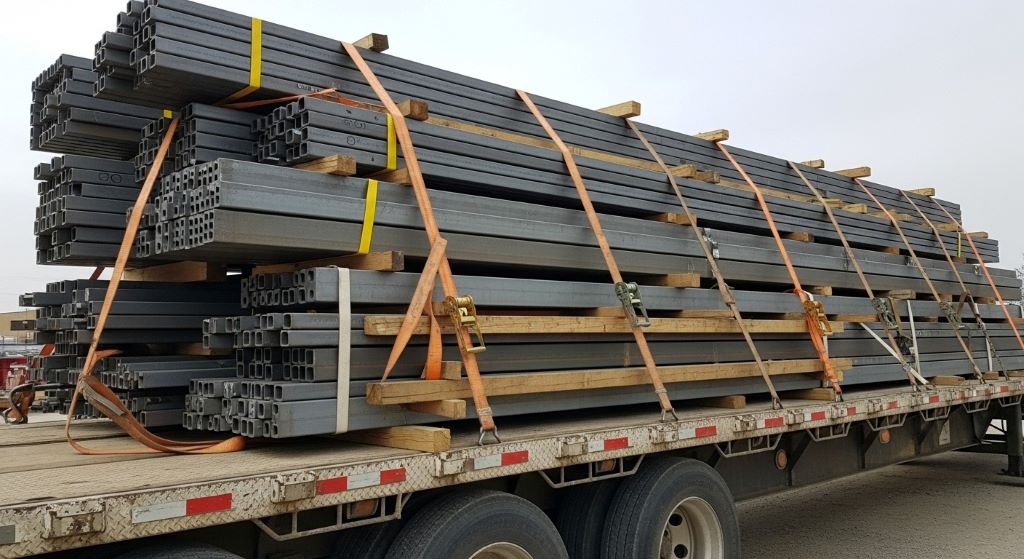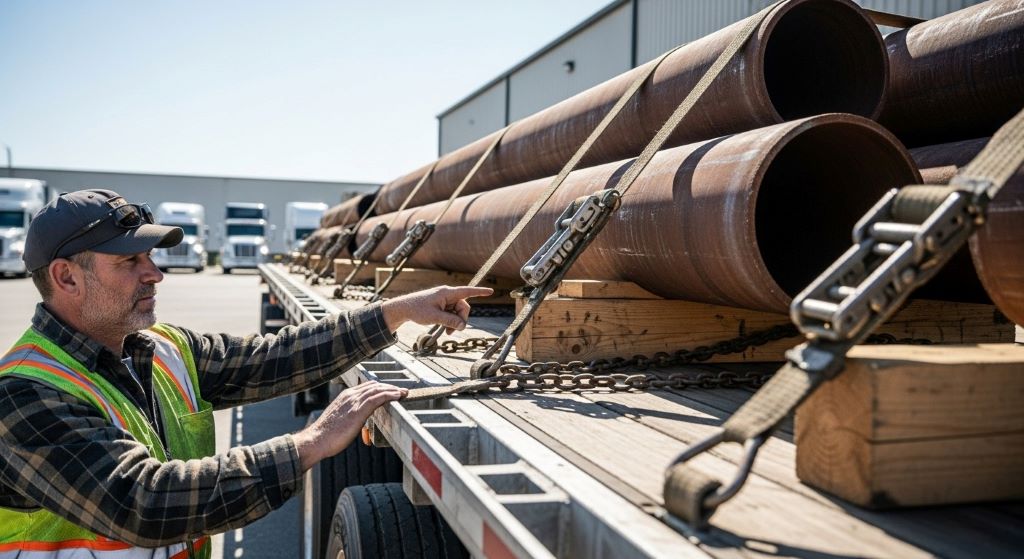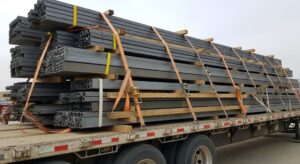How to Calculate Blocking vs Bracing Load Limits

Moving cargo safely on flatbed trailers requires more than just securing items with straps and chains. Understanding the difference between blocking and bracing, along with their load limits, ensures your cargo arrives intact while keeping you compliant with federal regulations. Businesses Automated provides solutions that help transportation companies manage these complex calculations efficiently.
When transporting heavy equipment, steel coils, or construction materials, drivers must determine whether blocking or bracing is appropriate for their specific load. These two securement methods work differently, and calculating their load limits correctly prevents cargo shift, damage, and potential accidents. The Federal Motor Carrier Safety Administration (FMCSA) sets clear standards for cargo securement, but many drivers struggle with the mathematical aspects of these requirements.
Professional drivers and fleet managers benefit from mastering flatbed trailer load securement calculations to ensure every load meets safety standards. These calculations determine how much force your blocking or bracing system must withstand during normal transportation conditions. Getting these numbers right protects your cargo, your equipment, and everyone sharing the road with you.
Understanding Blocking and Bracing Fundamentals
Blocking and bracing serve distinct purposes in cargo securement. Blocking prevents forward movement by placing a barrier directly in front of the cargo. Bracing prevents rearward or sideways movement by applying pressure against the cargo from behind or the sides.
The key difference lies in how these systems resist forces. Blocking works through direct compression, absorbing energy when cargo tries to slide forward during braking. Bracing functions similarly but addresses different directions of movement. Both methods must withstand specific force levels based on your cargo weight.
According to FMCSA regulations, your securement system must resist forces equal to 80% of cargo weight in the forward direction, 50% laterally, and 50% rearward. These percentages form the foundation of all blocking and bracing calculations. Additionally, understanding weight distribution across your trailer prevents overloading specific axles.
Calculating Blocking Load Limits
Calculating blocking load limits starts with determining the forward force your blocking system must resist. Multiply your cargo weight by 0.8 to find this value. For example, a 10,000-pound load requires blocking capable of resisting 8,000 pounds of forward force.
Next, evaluate your blocking material’s strength. Different materials provide varying levels of resistance. Hardwood blocking typically withstands higher compression forces than softwood. Steel blocking offers the greatest strength but adds weight to your trailer.
Consider the contact area between your blocking and the cargo. Smaller contact areas concentrate forces, potentially crushing the blocking material or damaging cargo. Larger contact areas distribute forces more evenly, improving system effectiveness. Calculate the pressure per square inch by dividing total force by contact area.
Your blocking must also attach securely to the trailer deck. Weak attachment points create system failure regardless of blocking material strength. Use deck rings, stake pockets, or other approved mounting points that meet manufacturer specifications. The FMCSA provides detailed guidance on acceptable attachment methods through their cargo securement rules.
Determining Bracing Load Limits
Bracing calculations follow similar principles but address different directional forces. For rearward bracing, multiply cargo weight by 0.5 to determine required resistance. A 10,000-pound load needs bracing that can resist 5,000 pounds of rearward force.
Lateral bracing calculations also use the 50% multiplier. However, lateral bracing often requires different positioning and materials compared to rearward bracing. The brace angle affects its efficiency, with perpendicular braces providing maximum effectiveness.
When braces attach at angles other than perpendicular, you must account for force vector components. A brace at 45 degrees resists less force than the same brace positioned at 90 degrees. Use trigonometric functions to calculate effective bracing force at various angles.
Material selection impacts bracing effectiveness significantly. Telescoping braces offer adjustability but may have lower load ratings than fixed braces. Always check manufacturer specifications for rated load capacity. Never exceed these ratings, as brace failure during transport creates dangerous situations.
Factors Affecting Load Limit Calculations
Several variables influence your blocking and bracing load calculations beyond basic weight and direction. Cargo center of gravity affects how forces distribute during transportation. High centers of gravity increase tipping risks and may require additional securement.
Road conditions and driving behavior impact the forces your securement system experiences. Emergency braking generates higher forces than normal stopping. Rough roads create dynamic loading that standard calculations may not fully account for. Therefore, building safety margins into your calculations provides extra protection.
Temperature changes affect material properties. Wood blocking may weaken when wet, while metal components can become brittle in extreme cold. Consider environmental conditions when selecting materials and calculating load limits.
Multiple pieces of cargo on one trailer complicate calculations. Each piece requires its own securement analysis. Adjacent cargo items may support each other or create additional loading scenarios. Analyze each configuration carefully to ensure comprehensive protection.

Combining Blocking, Bracing, and Tie-Downs
Most loads require combinations of blocking, bracing, and tie-downs for complete securement. These systems work together, with each component contributing to overall load stability. However, you cannot simply add their capacities together without considering how they interact.
Tie-downs provide vertical restraint and some lateral resistance. They complement blocking and bracing by preventing cargo lift and helping resist sideways movement. Calculate tie-down requirements separately using working load limits and the 50% rule for aggregate working load limit.
When blocking and tie-downs work together, the blocking handles primary forward resistance while tie-downs provide backup security. This redundancy improves safety margins. Similarly, bracing and tie-downs can share responsibilities for lateral and rearward resistance.
Document all calculations for your specific load configuration. Keep records of material specifications, attachment points, and safety factors used. This documentation proves compliance during inspections and helps you refine securement strategies over time.
Practical Application and Safety Margins
Always include safety margins in your calculations. Real-world conditions often exceed theoretical scenarios. A common approach adds 10-20% capacity beyond calculated minimum requirements. This buffer accounts for unexpected forces and material degradation.
Regular inspection of blocking and bracing materials ensures they maintain rated capacities. Cracked wood, bent metal, or damaged attachment points compromise system integrity. Replace questionable components immediately rather than risking load failure.
Training personnel in proper calculation methods reduces errors and improves safety culture. Everyone involved in loading operations should understand basic principles even if they use software tools for detailed calculations. Knowledge empowers better decision-making in the field.
Testing your securement systems during short initial movements can reveal problems before long hauls. Check blocking and bracing after the first few miles of travel. Cargo often settles during initial movement, potentially loosening securement components.
Conclusion
Calculating blocking and bracing load limits protects cargo, equipment, and lives. These calculations require understanding federal regulations, material properties, and force directions. Start with cargo weight and apply appropriate percentage multipliers for each direction of potential movement. Consider contact areas, attachment points, and material strength ratings when designing your securement system.
Remember that blocking resists forward movement through compression while bracing prevents rearward and lateral shift. Both must work within their rated capacities and attach securely to the trailer. Combine these methods with appropriate tie-downs for comprehensive cargo protection. Always include safety margins and inspect systems regularly to maintain effectiveness throughout the transportation process.
Frequently Asked Questions
What is the minimum percentage of cargo weight that blocking must resist?
Blocking must resist at least 80% of cargo weight in the forward direction according to FMCSA regulations. This means a 5,000-pound load requires blocking capable of withstanding 4,000 pounds of forward force during normal transportation conditions.
Can I use the same calculations for all types of cargo?
No, different cargo types require adjusted calculations based on their characteristics. Fragile items, high center-of-gravity loads, and cargo with unusual shapes need specialized securement approaches. Always consider specific cargo properties when calculating load limits.
How often should I inspect blocking and bracing during transport?
Inspect blocking and bracing components before departure, within the first 50 miles of travel, and every 150 miles or 3 hours thereafter. Also check after any significant event such as emergency braking or rough road conditions.
What happens if my blocking or bracing fails during transport?
Failed blocking or bracing can allow cargo to shift, potentially causing trailer imbalance, cargo damage, or accidents. Stop immediately if you suspect securement failure and do not continue until you properly restore cargo security. Continuing with compromised securement violates safety regulations.
Do I need special certifications to perform load securement calculations?
While no special certification is required for basic calculations, commercial drivers must understand cargo securement principles as part of CDL requirements. Advanced training programs and company-specific certifications help ensure proper technique and compliance with regulations.
Related Topics:








